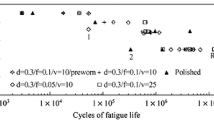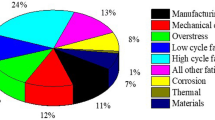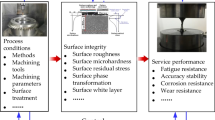Abstract
The mechanical friction leads to a large amount of energy consumption every year. To decrease the friction and wear and prolong the service life of the working components are therefore significant for energy sustainable development. To this end, many researchers investigate how to improve the tribological and wear resistance of the components by mechanical machining. The current article reviews the influence of common mechanical processes (i.e., grinding, turning, and milling) on the wear performance of machined surfaces in terms of hardness, surface morphology, and residual stresses. The strengthening mechanism of machined surface in the wear performance can be attributed to (i) the high hardness that improves the wear performance by preventing the insertion of wear particles on the friction surface; (ii) the induced surface texture that improves the wear resistance by storing the lubricating oil and wear debris for alleviating the subsequent friction; and (iii) the high compressive residual stress that mitigates the surface worn by preventing the formation and propagation of crack defects. In order to service under different conditions, it indicates that the control of hardness, texture, and residual stress by optimizing the process parameter could improve the wear performance of the machined surface. This review can deepen the understanding of the enhancement mechanism of wear resistance of the mechanically machined surfaces to obtain the better performance of components.









Similar content being viewed by others
Availability of data and material
All data generated or analyzed during this study are included in the present article.
References
Holmberg K, Erdemir A (2017) Influence of tribology on global energy consumption, costs and emissions. Friction 5:263–284. https://doi.org/10.1007/s40544-017-0183-5
Holmberg K, Kivikytö-Reponen P, Härkisaari P et al (2017) Global energy consumption due to friction and wear in the mining industry. Tribol Int 115:116–139. https://doi.org/10.1016/j.triboint.2017.05.010
Holmberg K, Siilasto R, Laitinen T, Andersson P, Jsberg A (2013) Global energy consumption due to friction in paper machines. Tribol Int 62:58–77. https://doi.org/10.1016/j.triboint.2013.02.003
la Monaca A, Murray JW, Liao Z, Speidel A, Robels-Linars JA, Axinte DA, Hardy MC, Clare AT (2021) Surface integrity in metal machining - part II: functional performance. Int J Mach Tools Manuf 164:103718. https://doi.org/10.1016/j.ijmachtools.2021.103718
Mishina H, Hase A (2019) Effect of the adhesion force on the equation of adhesive wear and the generation process of wear elements in adhesive wear of metals. Wear 432:202936. https://doi.org/10.1016/j.wear.2019.202936
Baydoun S, Arnaud P, Fouvry S (2022) Explicit formulations of adhesive wear extension in fretting interfaces applying the contact oxygenation concept. Wear 488:204147. https://doi.org/10.1016/j.wear.2021.204147
Aghababaei R, Zhao K (2021) Micromechanics of material detachment during adhesive wear: a numerical assessment of Archard’s wear model. Wear 476:203739. https://doi.org/10.1016/j.wear.2021.203739
Purba RH, Shimizu K, Kusumoto K, Gaqi Y, Todaka T (2022) Effect of boron addition on three-body abrasive wear characteristics of high chromium based multi-component white cast iron. Mater Chem Phys 275:125232. https://doi.org/10.1016/j.matchemphys.2021.125232
Zou S, Zhao Z, Xu W, Ni X, Zhang L, Wu W, Kong D, He X, Wang L, Dong C (2022) Effects of scanning speeds on the wear behavior of CoCrW alloy fabricated by selective laser melting. Opt Laser Technol 147:107652. https://doi.org/10.1016/j.optlastec.2021.107652
Khan MM, Dey A (2022) Hybrid MCDM approach for examining the high-stress abrasive wear behaviour of in situ ZA-27/TiCp MMCs. Mater Chem Phys 277:125319. https://doi.org/10.1016/j.matchemphys.2021.125319
Zhang R, Zheng C, Chen C, Lv B, Gao G, Yang Z, Yang Y, Zhang F (2021) Study on fatigue wear competition mechanism and microstructure evolution on the surface of a bainitic steel rail. Wear 482:203978. https://doi.org/10.1016/j.wear.2021.203978
Wang S, Zhong H, Zhang P, Chen H, Zhao S (2020) Effect of different hardness units on fatigue wear resistance of low hardenability steel. Opt Laser Technol 130:106325. https://doi.org/10.1016/j.optlastec.2020.106325
Ahmadi A, Sadeghi F, Shaffer S (2018) In-situ friction and fretting wear measurements of Inconel 617 at elevated temperatures. Wear 410:110–118. https://doi.org/10.1016/j.wear.2018.06.007
Bhosale DG, Prabhu TR, Rathod WS (2020) Sliding and erosion wear behaviour of thermal sprayed WC-Cr3C2-Ni coatings. Surf Coat Technol 400:126192. https://doi.org/10.1016/j.surfcoat.2020.126192
Li C, Bin G, Li J, Liu Z (2021) Study on the erosive wear of the gas-solid flow of compressor blade in an aero-turboshaft engine based on the Finnie model. Tribol Int 163:107197. https://doi.org/10.1016/j.triboint.2021.107197
Matikainen V, Peregrina SR, Ojala N, Koivuluoto H, Schubert J, Houdková Š, Vuoristo P (2019) Erosion wear performance of WC-10Co4Cr and Cr3C2-25NiCr coatings sprayed with high-velocity thermal spray processes. Surf Coat Technol 370:196–212. https://doi.org/10.1016/j.surfcoat.2019.04.067
Zuo J, Lin Y, Zhong P, Liu Y (2020) Investigation on adhesive wear process of tool coating surface under high-adhesive rate environment in cutting Beryllium-copper C17200 alloy. Mater Lett 279:128488. https://doi.org/10.1016/j.matlet.2020.128488
Poria S, Sutradhar G, Sahoo P (2019) Design of experiments analysis of abrasive wear behavior of stir Cast Al-TiB2 composites. Mater Today Proc 18:4253–4260. https://doi.org/10.1016/j.matpr.2019.07.383
Ma L, He CG, Zhao XJ, Guo J, Zhu Y, Wang W, Liu Q, Jin X (2016) Study on wear and rolling contact fatigue behaviors of wheel/rail materials under different slip ratio conditions. Wear 366:13–26. https://doi.org/10.1016/j.wear.2016.04.028
Gómez-Guarneros MA, Domínguez-Cabrera BA, Quinto-Saure C, Farfan-Cabrera LI, Santander-Reyes JN, Gallardo-Hernández EA (2021) Investigating the erosive wear caused by dry-ice blasting in paint stripping process. Mater Lett. https://doi.org/10.1016/j.matlet.2021.131203
Philip JT, Kumar D, Mathew J, Kuriachen B (2020) Tribological investigations of wear resistant layers developed through EDA and WEDA techniques on Ti6Al4V surfaces: part I – ambient temperature. Wear 458:203409. https://doi.org/10.1016/j.wear.2020.203409
Hu T, Hu L, Ding Q (2012) The effect of laser surface texturing on the tribological behavior of Ti-6Al-4V. Proc Institution Mech Eng Part J J Eng Tribol 226:854–863. https://doi.org/10.1177/1350650112450801
Wang PF, Han Z, Lu K (2018) Enhanced tribological performance of a gradient nanostructured interstitial-free steel. Wear 402:100–108. https://doi.org/10.1016/j.wear.2018.02.010
Sichani MSh, Bezin Y (2018) Differential wear modelling – effect of weld-induced material inhomogeneity on rail surface quality. Wear 406:43–52. https://doi.org/10.1016/j.wear.2018.03.019
Belkhir N, Bouzid D, Herold V (2007) Correlation between the surface quality and the abrasive grains wear in optical glass lapping. Tribol Int 40:498–502. https://doi.org/10.1016/j.triboint.2006.05.001
Wang H, He D, Wu Y, Xu S (2021) Study on wear state evaluation of friction stir welding tools based on image of surface topography. Measurement 186:110173. https://doi.org/10.1016/j.measurement.2021.110173
Zhang Y, Li C, Jia D, Zhang D, Zhang X (2015) Experimental evaluation of the lubrication performance of MoS2/CNT nanofluid for minimal quantity lubrication in Ni-based alloy grinding. Int J Mach Tools Manuf 99:19–33. https://doi.org/10.1016/j.ijmachtools.2015.09.003
Kato H, Ueki H, Yamamoto K, Yasunaga K (2018) Wear resistance improvement by nanostructured surface layer produced by burnishing. Mater Sci Forum 917:231–235. https://doi.org/10.4028/www.scientific.net/msf.917.231
Marchenko DD, Dykha AV, Artyukh VA, Matvyeyeva KS (2020) Studying the tribological properties of parts hardened by rollers during stabilization of the operating rolling force. J Frict Wear 41:58–64. https://doi.org/10.3103/s1068366620010122
Nouri H, Farahnakian M, Elhami S (2016) Experimental study on the wettability of microtextured surfaces generated by the ultrasonic-assisted face turning. Proc Institution Mech Eng Part J J Eng Tribol 231:655–663. https://doi.org/10.1177/1350650116672144
da Silva SP, Abrão AM, da Silva ER, Câmara MA (2020) Surface modification of AISI H13 steel by die-sinking electrical discharge machining and TiAlN coating: a promising hybrid technique to improve wear resistance. Wear 462:203509. https://doi.org/10.1016/j.wear.2020.203509
Shiyas KA, Ramanujam R (2021) A review on post processing techniques of additively manufactured metal parts for improving the material properties. Mater Today Proc 46:1429–1436. https://doi.org/10.1016/j.matpr.2021.03.016
Yang M, Li C, Zhang Y, Jia D, Zhang X, Hou Y, Li R, Wang J (2017) Maximum undeformed equivalent chip thickness for ductile-brittle transition of zirconia ceramics under different lubrication conditions. Int J Mach Tools Manuf 122:55–65. https://doi.org/10.1016/j.ijmachtools.2017.06.003
Mruthunjaya M, Yogesha KB (2021) A review on conventional and thermal assisted machining of titanium based alloy. Mater Today Proc 46:8466–8472. https://doi.org/10.1016/j.matpr.2021.03.490
Wang B, Castellana J, Melkote SN (2021) A hybrid post-processing method for improving the surface quality of additively manufactured metal parts. Cirp Ann 70:175–178. https://doi.org/10.1016/j.cirp.2021.03.010
Ndaliman MB, Khan AA, Ali MY (2012) Influence of electrical discharge machining process parameters on surface micro-hardness of titanium alloy. Proc Institution Mech Eng Part B J Eng Manuf 227:460–464. https://doi.org/10.1177/0954405412470443
Ekmekci B, Güngör E (2017) A comparative study on the wear resistance of electrical discharge machined surfaces. Mach Sci Technol 21:1–19. https://doi.org/10.1080/10910344.2017.1336180
Atzeni E, Barletta M, Calignano F, Luliano L, Rubino G, Tagliaferri V (2016) Abrasive fluidized bed (AFB) finishing of AlSi10Mg substrates manufactured by direct metal laser sintering (DMLS). Addit Manuf 10:15–23. https://doi.org/10.1016/j.addma.2016.01.005
Shen X, Zhang J (2013) Studies on friction and wear properties of surface produced by ultrasonic vibration-assisted milling. Int J Adv Manuf Technology 67:349–356. https://doi.org/10.1007/s00170-012-4488-2
Zhang D, Gao F, Wei X, Liu G, Meng H, Li P (2018) Fabrication of textured composite surface and its tribological properties under starved lubrication and dry sliding conditions. Surf Coat Technol 350:313–322. https://doi.org/10.1016/j.surfcoat.2018.07.026
Bensaid K, Dhiflaoui H, Bouzaiene H, Yahyaoui H, Fredj N (2021) Effects of the cooling mode on the integrity and the multi-pass micro-scratching wear resistance of Hardox 500 ground surfaces. Int J Adv Manuf Technol 113:2865–2882. https://doi.org/10.1007/s00170-021-06719-x
Liu P, Quan Y, Wan J, Yu L (2021) Experimental investigation on the wear and damage behaviors of machined wheel-rail materials under dry sliding conditions. Materials 14:540. https://doi.org/10.3390/ma14030540
Bertolini R, Ghiotti A, Bruschi S (2021) Wear behavior of Ti6Al4V surfaces functionalized through ultrasonic vibration turning. J Mater Eng Perform 1–12. https://doi.org/10.1007/s11665-021-05952-5
Tan YF, Wang YH, Yu AB et al (2004) Effects of grinding on the wear resistance of ZTM composites. Key Eng Mat 259–260:366–369. https://doi.org/10.4028/www.scientific.net/kem.259-260.366
Sedlaček M, Podgornik B, Vižintin J (2009) Influence of surface preparation on roughness parameters, friction and wear. Wear 266:482–487. https://doi.org/10.1016/j.wear.2008.04.017
Baharin AFS, Ghazali MJ, Wahab JA (2016) Laser surface texturing and its contribution to friction and wear reduction: a brief review. Ind Lubr Tribol 68:57–66. https://doi.org/10.1108/ilt-05-2015-0067
Zhang M, Tan Y, Zhou F, Mao C, Xie Z (2017) Analysis of flow field in cutting zone for spiral orderly distributed fiber tool. Int J Adv Manuf Technol 92:4345–4354. https://doi.org/10.1007/s00170-017-0471-2
Gao T, Li C, Yang M, Zhang Y, Jia D, Ding W, Debnath S, Yu T, Said Z, Wang J (2021) Mechanics analysis and predictive force models for the single-diamond grain grinding of carbon fiber reinforced polymers using CNT nano-lubricant. J Mater Process Technol 290:116976. https://doi.org/10.1016/j.jmatprotec.2020.116976
Chen Z, Wen D, Lu J, Yang J (2021) Surface quality improvement by using a novel driving system design in single-side planetary abrasive lapping. Materials 14:1691. https://doi.org/10.3390/ma14071691
Murthy JKN, Rao DS, Venkataraman B (2001) Effect of grinding on the erosion behaviour of a WC–Co–Cr coating deposited by HVOF and detonation gun spray processes. Wear 249:592–600. https://doi.org/10.1016/s0043-1648(01)00682-2
Amini S, Hosseinabadi HN, Sajjady SA (2016) Experimental study on effect of micro textured surfaces generated by ultrasonic vibration assisted face turning on friction and wear performance. Appl Surf Sci 390:633–648. https://doi.org/10.1016/j.apsusc.2016.07.064
Maiti AK, Mukhopadhyay N, Raman R (2009) Improving the wear behavior of WC-CoCr-based HVOF coating by surface grinding. J Mater Eng Perform 18:1060. https://doi.org/10.1007/s11665-009-9354-5
Archard JF (1953) Contact and rubbing of flat surfaces. J Appl Phys 24:981–988. https://doi.org/10.1063/1.1721448
Bartha BB, Zawadzki J, Chandrasekar S, Farris TN (2004) Wear of hard-turned AISI 52100 steel. Metal Mater Trans A 36:1417. https://doi.org/10.1007/s11661-005-0234-9
Wheeler DW, Wood RJK (2005) Erosion of hard surface coatings for use in offshore gate valves. Wear 258:526–536. https://doi.org/10.1016/j.wear.2004.03.035
Hou G, Li A (2021) Effect of surface micro-hardness change in multistep machining on friction and wear characteristics of titanium alloy. Appl Sci 11:7471. https://doi.org/10.3390/app11167471
Shen X-H, Tao G-C (2015) Tribological behaviors of two micro textured surfaces generated by vibrating milling under boundary lubricated sliding. Int J Adv Manuf Technol 79:1995–2002. https://doi.org/10.1007/s00170-015-6965-x
Zoei MS, Sadeghi MH, Salehi M (2016) Effect of grinding parameters on the wear resistance and residual stress of HVOF-deposited WC–10Co–4Cr coating. Surf Coat Technol 307:886–891. https://doi.org/10.1016/j.surfcoat.2016.09.067
Huang W, Zhao J, Wang S (2019) Necessity of multidimensional evaluation of the high-speed ball-end milled surface of hardened AISI D2 steel from a wear resistance perspective. Int J Adv Manuf Technol 103:4085–4093. https://doi.org/10.1007/s00170-019-03768-1
Chen X, Zhai W, Dong S, Zheng K, Xu R, Wang J, Liu X, Lu W (2020) Investigations on torsional fretting wear properties of CuAlNi processed by ultrasonic vibration-assisted milling. Tribol Int 146:106238. https://doi.org/10.1016/j.triboint.2020.106238
Yasavol N, Ramalho A (2015) Wear properties of friction stir processed AISI D2 tool steel. Tribol Int 91:177–183. https://doi.org/10.1016/j.triboint.2015.07.001
Singh K, Khatirkar RK, Sapate SG (2015) Microstructure evolution and abrasive wear behavior of D2 steel. Wear 328:206–216. https://doi.org/10.1016/j.wear.2015.02.019
Tang L, Gao C, Huang J, Zhang H, Chang W (2013) Dry sliding friction and wear behaviour of hardened AISI D2 tool steel with different hardness levels. Tribol Int 66:165–173. https://doi.org/10.1016/j.triboint.2013.05.006
Zhang W, Zhang L, Zheng M, Wang B (2021) Analysis of wear resistance based on milling topography. Integr Ferroelectr 218:119–128. https://doi.org/10.1080/10584587.2021.1911333
Yang SC, Cui XY, Zhang YH, Wang ZW (2016) Effect of tool wear on surface qualities in milling of TC4. Mater Sci Forum 836–837:132–138. https://doi.org/10.4028/www.scientific.net/msf.836-837.132
Fadin VV, Aleutdinova MI, Rubtsov VE, Aleutdinova VA (2016) Structure and worn surface morphology on copper containing composites under dry sliding with high contact current density. Key Eng Mat 712:137–142. https://doi.org/10.4028/www.scientific.net/kem.712.137
Zhang Z, Shao F, Liang Y, Lin P, Ren L (2017) Wear behavior of medium carbon steel with biomimetic surface under starved lubricated conditions. J Mater Eng Perform 26:3420–3430. https://doi.org/10.1007/s11665-017-2607-9
Zheng M, Wang B, Zhang W, Cui Y, Zhang L, Zhao S (2020) Analysis and prediction of surface wear resistance of ball-end milling topography. Surf Topogr Metrol Prop 8:025032. https://doi.org/10.1088/2051-672x/ab9d70
Hosseinabadi HN, Sajjady SA, Amini S (2018) Creating micro textured surfaces for the improvement of surface wettability through ultrasonic vibration assisted turning. Int J Adv Manuf Technol 96:2825–2839. https://doi.org/10.1007/s00170-018-1580-2
Chen L, Liu Z, Li Y, Shi Z (2018) Effects of micro-milled malposed dimple structures on tribological behavior of Al-Si alloy under droplet lubricant condition. Int J Adv Manuf Technol 98:143–150. https://doi.org/10.1007/s00170-017-0603-8
Wei J, Lin B, Wang H, Sui T, Yan S, Zhao F, Wang A, Fang S (2018) Friction and wear characteristics of carbon fiber reinforced silicon carbide ceramic matrix (Cf/SiC) composite and zirconia (ZrO2) ceramic under dry condition. Tribol Int 119:45–54. https://doi.org/10.1016/j.triboint.2017.10.023
Zhang JH, Ge PQ, Zhang L, Yu Y, Li H (2010) Study on the friction and wear behavior of grind-hardened layer. Key Eng Mat 431–432:385–388. https://doi.org/10.4028/www.scientific.net/kem.431-432.385
Bhaumik S, Chowdhury D, Batham A, Sehgal U, Datta S (2020) Analysing the frictional properties of micro dimpled surface created by milling machine under lubricated condition. Tribol Int 146:106260. https://doi.org/10.1016/j.triboint.2020.106260
Ba ECT, Dumont MR, Martins PS, Drumond RM, Vieira VF (2021) Investigation of the effects of skewness Rsk and kurtosis Rku on tribological behavior in a pin-on-disc test of surfaces machined by conventional milling and turning processes. Mater Res. https://doi.org/10.1590/1980-5373-mr-2020-0435
Kuzin VV, Fedorov SYu, Seleznev AE (2016) Effect of conditions of diamond grinding on tribological behavior of alumina-based ceramics. J Frict Wear 37:371–376. https://doi.org/10.3103/s1068366616040097
Whitehouse DJ (1997) Surface metrology. Meas Sci Technol 8:955. https://doi.org/10.1088/0957-0233/8/9/002
Yan X-L, Wang X-L, Zhang Y-Y (2014) Influence of roughness parameters skewness and kurtosis on fatigue life under mixed elastohydrodynamic lubrication point contacts. J Tribol 136:031503. https://doi.org/10.1115/1.4027480
Zhang Y, Li C, Ji H, Yang X, Yang M, Jia D, Zhang X, Li R, Wang J (2017) Analysis of grinding mechanics and improved predictive force model based on material-removal and plastic-stacking mechanisms. Int J Mach Tools Manuf 122:81–97. https://doi.org/10.1016/j.ijmachtools.2017.06.002
Funding
This work was financially supported by the National Natural Science Foundation of China (Nos. 52175415 and 51975302), the Natural Science Foundation of Jiangsu Province (No. BK20210866), and the Natural Science Foundation of the Jiangsu Higher Education Institutions of China (No. 21KJB460021).
Author information
Authors and Affiliations
Contributions
Weijie Kuang, data curation and original draft preparation. Qing Miao, data collection and manuscript revision. Wenfeng Ding, supervision, conceptualization, and methodology. Haonan Li, manuscript revision.
Corresponding author
Ethics declarations
Ethics approval and consent to participate
The article follows the guidelines of the Committee on Publication Ethics (COPE) and involves no studies on human or animal subjects.
Consent for publication
Not applicable.
Competing interests
The authors declare no competing interests.
Additional information
Publisher's Note
Springer Nature remains neutral with regard to jurisdictional claims in published maps and institutional affiliations.
Rights and permissions
About this article
Cite this article
Kuang, W., Miao, Q., Ding, W. et al. A short review on the influence of mechanical machining on tribological and wear behavior of components. Int J Adv Manuf Technol 120, 1401–1413 (2022). https://doi.org/10.1007/s00170-022-08895-w
Received:
Accepted:
Published:
Issue Date:
DOI: https://doi.org/10.1007/s00170-022-08895-w




